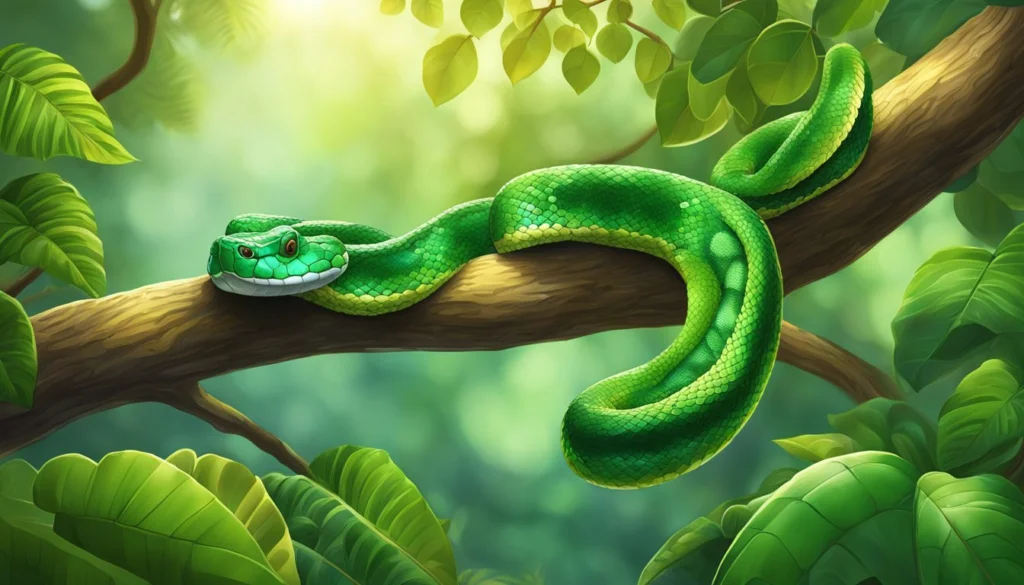The Emerald Tree Boa (Corallus caninus) is one of the most stunning and striking creatures found in the rainforests of South America. With its brilliant green coloration and graceful movements, this snake looks like a living gem among the dense foliage of its natural habitat. Known for its arboreal lifestyle, the Emerald Tree Boa spends most of its life coiled around tree branches, patiently waiting for prey. While its appearance is enough to captivate onlookers, the Emerald Tree Boa’s behaviors and adaptations make it an even more remarkable species.
In this article, we’ll explore some fascinating facts about the Emerald Tree Boa, including its habitat, diet, physical characteristics, and how it thrives in the lush, tropical rainforests.
Habitat: Where Does the Emerald Tree Boa Live?
The Emerald Tree Boa is native to the tropical rainforests of South America, particularly in countries like Brazil, Venezuela, Colombia, and Peru. These snakes prefer humid, lowland rainforests where they can find plenty of trees to climb and hide within. They are often found near rivers and swampy areas, where their prey is abundant.
Arboreal Lifestyle
As its name suggests, the Emerald Tree Boa is a fully arboreal species, meaning it spends most of its life in trees. Unlike ground-dwelling snakes, the Emerald Tree Boa is highly adapted to life in the canopy, where it uses its long, muscular body to wrap around branches and hang motionless for hours.
The trees of the rainforest provide the snake with not only a place to rest but also a hunting ground. The Emerald Tree Boa’s vivid green coloration allows it to blend seamlessly into the foliage, camouflaging it from both predators and prey.
Rainforest Climate
The rainforest provides an ideal environment for the Emerald Tree Boa, as it requires high humidity and warm temperatures to thrive. The constant canopy cover helps maintain stable temperatures, while the proximity to rivers and streams provides ample moisture.
Physical Characteristics: What Makes the Emerald Tree Boa So Beautiful?
The Emerald Tree Boa is renowned for its stunning appearance. Its vibrant green scales are not just visually striking; they also serve as excellent camouflage, allowing the snake to blend into the leaves and branches of the rainforest.
1. Coloration
The most noticeable feature of the Emerald Tree Boa is its emerald-green coloration, which is often accented by white or yellow zigzag patterns running along its back. These markings resemble the appearance of light filtering through the leaves and help break up the outline of the snake’s body, making it difficult for prey or predators to spot.
While adult Emerald Tree Boas are a vibrant green, the juveniles often start life with a very different color. Young boas are typically bright orange or red, which gradually changes to green as they mature. This color transformation can take up to a year or more.
2. Body Shape
Emerald Tree Boas are long, slender snakes with powerful muscles that allow them to coil around tree branches securely. They can grow up to 6 feet (1.8 meters) in length, although some individuals may reach up to 9 feet. Despite their length, they are not heavy-bodied like some other large snakes, which allows them to move gracefully through the treetops.
3. Teeth and Fangs
Emerald Tree Boas possess long, sharp teeth designed to grasp and hold onto their prey. Their teeth are among the longest of any non-venomous snake, curving backward to prevent prey from escaping once caught. These snakes are non-venomous, relying on their teeth and powerful constriction to subdue their prey.
4. Eyes and Vision
The Emerald Tree Boa has large, yellow eyes with vertical pupils, which give it excellent night vision. As a primarily nocturnal hunter, it uses its keen eyesight to detect movement in the dim light of the rainforest.
Diet: What Do Emerald Tree Boas Eat?
Emerald Tree Boas are carnivorous, feeding on a diet primarily composed of small mammals and birds. Their position high in the trees allows them to catch prey that lives or moves through the canopy, such as small rodents, birds, and sometimes even lizards.
1. Hunting Technique
The Emerald Tree Boa is an ambush predator, meaning it lies in wait for its prey to come within striking distance. Coiled motionlessly on a branch, the boa strikes out at lightning speed when it senses prey nearby, using its long teeth to secure the animal. Once the prey is caught, the snake coils around it tightly and constricts it until it can no longer breathe.
Unlike venomous snakes, which inject toxins to subdue their prey, the Emerald Tree Boa relies entirely on constriction to kill its meals. After subduing the prey, the boa will swallow it whole, headfirst, using its strong jaws and teeth to guide the food into its mouth.
2. Diet in the Wild
In the wild, the Emerald Tree Boa’s diet consists mainly of rodents, such as small rats and mice, as well as birds. Occasionally, it may also feed on bats or lizards if they are available. Juvenile boas, which are smaller, tend to feed on smaller prey like frogs or lizards until they grow large enough to tackle bigger animals.
Behavior: How Does the Emerald Tree Boa Live?
Emerald Tree Boas are solitary animals that spend most of their time alone in the trees. They are generally slow-moving and prefer to conserve their energy by resting motionless for hours or even days between hunts. These boas are nocturnal, meaning they are most active at night when they hunt for food.
1. Coiling Behavior
One of the most characteristic behaviors of the Emerald Tree Boa is its coiling posture. When at rest, the snake coils its body around a tree branch, forming a series of loops with its head resting in the center. This position allows the snake to remain alert while conserving energy and remaining well-camouflaged.
This coiling posture is also practical for hunting, as it allows the boa to strike quickly at passing prey without needing to move much.
2. Non-Aggressive Nature
Despite their fearsome appearance, Emerald Tree Boas are generally not aggressive toward humans. In the wild, they prefer to avoid confrontation, using their camouflage to blend into the trees rather than engage with potential threats. However, like most animals, they will defend themselves if threatened.
Reproduction: The Life Cycle of an Emerald Tree Boa
Emerald Tree Boas are ovoviviparous, meaning that they give birth to live young rather than laying eggs. This reproductive strategy is relatively rare among snakes and offers advantages in their humid rainforest habitat.
1. Mating and Gestation
Emerald Tree Boas typically breed during the rainy season when food is plentiful. After mating, the female carries the developing embryos inside her body for a gestation period of about 6 to 7 months. During this time, the embryos develop within eggs that are retained inside the female.
2. Birth of Live Young
Once the gestation period is complete, the female gives birth to live young. The juveniles are usually bright orange or red when they are born, a stark contrast to the green coloration of the adults. A typical litter can contain anywhere from 5 to 12 young, although larger litters have been observed.
3. Juvenile Development
Juvenile Emerald Tree Boas are fully independent from the moment they are born. They begin hunting small prey immediately and gradually transition to a green coloration over the course of their first year. As they grow, they shed their skin periodically, a process that helps them develop their adult appearance.
Conservation Status and Threats
While the Emerald Tree Boa is not currently considered endangered, it does face several threats due to habitat destruction and the illegal pet trade. The rainforests of South America are under constant threat from deforestation, which impacts the habitats of many species, including the Emerald Tree Boa.
1. Habitat Loss
The destruction of rainforests for agriculture, logging, and human development is a significant threat to the Emerald Tree Boa. As these forests are cleared, the snake loses its natural habitat and access to prey.
2. Illegal Pet Trade
Emerald Tree Boas are popular among reptile enthusiasts due to their striking appearance. Unfortunately, this demand has led to illegal collection of wild specimens, which can have a detrimental effect on local populations. Captive breeding programs have helped reduce the demand for wild-caught snakes, but illegal trade remains a concern.
Fascinating Facts About the Emerald Tree Boa
- Color Change: Juvenile Emerald Tree Boas are born bright orange or red and gradually change to green as they mature.
- Ambush Hunter: The Emerald Tree Boa is an ambush predator, lying in wait on tree branches for prey to pass by before striking.
- Non-Venomous: Despite its large teeth and fearsome appearance, the Emerald Tree Boa is non-venomous, relying on constriction to subdue its prey.
- Excellent Camouflage: The snake’s emerald-green coloration allows it to blend perfectly into the rainforest canopy, making it nearly invisible to predators and prey.
- Live Births: Unlike most snakes, which lay eggs, the Emerald Tree Boa gives birth to live young.
Conclusion
The Emerald Tree Boa is truly a jewel of the rainforest. Its vibrant green scales, unique hunting strategies, and arboreal lifestyle make it one of the most fascinating snakes in the world. Although it faces threats from habitat loss and illegal trade, the Emerald Tree Boa continues to thrive in the dense rainforests of South America. With its stunning beauty and fascinating behaviors, it remains a symbol of the incredible biodiversity found in these tropical ecosystems.
FAQs
Is the Emerald Tree Boa dangerous to humans?
No, the Emerald Tree Boa is not considered dangerous to humans. It is non-venomous and typically avoids confrontation. However, like most wild animals, it may defend itself if threatened.
How long do Emerald Tree Boas live?
In the wild, Emerald Tree Boas can live for around 15 years, while in captivity, with proper care, they may live up to 20 years.
What do Emerald Tree Boas eat?
Emerald Tree Boas primarily eat small mammals and birds. They are ambush predators that lie in wait for prey to come within striking distance.
How big do Emerald Tree Boas get?
Emerald Tree Boas can grow up to 6 feet (1.8 meters) in length, although some individuals may reach up to 9 feet.
Where are Emerald Tree Boas found?
Emerald Tree Boas are native to the rainforests of South America, particularly in Brazil, Venezuela, Colombia, and Peru. They live in trees and are commonly found near rivers and swampy areas.


